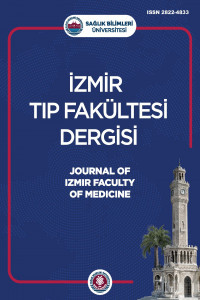Çocukluklarda Derin Boyun Enfeksiyonlarının Değerlendirilmesi: 5 Yıllık Retrospektif Çalışma
Çocuk, derin boyun enfeksiyonları, parafaringeal apse, peritonsiller apse, retrofaringeal apse
Evalution of Deep Neck Infections in Childhood: A-5 Year Retrospective Study
___
- Referans1.Goldstein NA, Hammerschlag MR. Peritonsillar, retropharyngeal, and parapharyngeal abscess. In: Feigin RD, Demmler GJ, Cherry JD, et al., editors. Textbook of Pediatric Infectious Disease. 2004. 5th ed ed. Philadelphia: WB Saunders. p. 178-85.
- Referans2.Chang L, Chi H, Chiu NC, Huang FY, Lee KS. Deep neck infections in different age groups of children. J Microbiol Immunol Infect. 2010;43: 47-52.
- Referans3.Weed HG, Forrest LA. Deep neck infection. Otolaryngology Head and Neck Surgery'de Ed.Charles W. Cummings Third Edition, Volume Three, St. Lois, Missouri, 1998;1700-1.
- Referans4.Goldstein NA, Hammerschlag MR. Peritonsillar, retropharyngeal, and parapharyngeal abscesses. In: Feigin RD, Cherry JD, Harrison GJ, Kaplan SL, Steinbach WJ, Hotez BJ, editors. Textbook of Pediatric Infectious Disease, 8th ed. Philadelphia, PA: Elsevier, 2019. p: 117-23.
- Referans5. Parhiscar A, Har-El G. Deep neck abscess: A retrospective review of 210 cases. Ann Otol Rhinol Laryngol 2001;110:1051-4.
- Referans6. Baldassari CM, Howell R, Amorn M, Budacki R, Choi S, Pena M. Complications in pediatric deep neck space abscesses. Otolaryngol Head Neck Surg. 2011;144:592-5.
- Referans7.Huang TT, Liu TC, Chen PR, Tseng FY, Yeh TH, Chen YS. Deep neck infection: analysis of 185 cases. Head Neck. 2004;26: 854-60.
- Referans8.Chang L, Chi H, Chiu NC, Huang FY, Lee KS. Deep neck infections in different age groups of children. J Microbiol Immunol Infect. 2010;43:47-52.
- Referans9.Da Silva PS, Waisberg DR. Internal carotid artery pseudoaneurysm with life-threatening epistaxis as a complication of deep neck space infection. Pediatr Emerg Care. 2011; 27: 422-4.
- Referans10.Schwartz RH. Infections related to the upper and middle airways. In: Long SS, Pickering LK, Prober CG editors. Pediatric Infectious Diseases. 3rd ed. Churchill Livingstone Elsevier; 2008; p: 213-7.
- Referans11. Brook I. Microbiology and management of peritonsillar, retropharyngeal, and parapharyngeal abscesses. J Oral Maxillofac Surg. 2004;62:1545-50.
- Referans12. Tan PT, Chang LY, Huang YC, Chiu CH, Wang CR, Lin TY. Deep neck infections in children. J Microbiol Immunol Infect. 2001;34:287-92.
- Referans13. Yang YS, Lee HU, Lee SH, Hong KH. A clinical study of the deep neck infections in children. Korean J Otolaryngol – Head Neck Surg. 2004;47:1282-8. Referans14. Bottin R, Marioni G, Rinaldi R, Boninsegna M, Salvadori L, Staffieri A. Deep neck infection: a present-day complication. A retrospective review of 83 cases (1998-2001). Eur Arch Otorhinolaryngol. 2003;260:576-9.
- Referans15. Ünsal Tuna EE, Özel E, Özbek C, Özdem C. Derin boyun enfeksiyonu: 63 hastanın incelenmesi. Turk Arch Otolaryngol. 2008;46:73-7. Referans16. Coticchia JM, Getnick GS, Yun RD, Arnold JE. Age-, site-, and time-specific differences in pediatric deep neck abscesses. Arch Otolaryngol Head Neck Surg. 2004;130:201-7.
- Referans17. Larawin V, Naipao J, Dubey SP. Head and neck space infections. Otolaryngol Head Neck Surg. 2006;135:889-3.
- Referans18. Kaya EE, Taşar MA, Bilge YD. Evalutıon of deep neck infectionsin pediatric patients. Türkiye Çocuk Hast Derg. 2012;6:197-205.
- Referans19. Cmejrek RC, Coticchia JM, Arnold JE. Presentation, diagnosis, and management of deep-neck abscesses in infants. Arch Otolaryngol Head Neck Surg. 2002;128:1361-4.
- Referans20. Belet N, Tapısız A, Uçar Y. Deep neck infections in children. J Pediatr Inf. 2007;1:58-62.
- Referans21. Metin Ö, Öz FN, Tanır G. Deep neck infections in children: experience in a tertiary care center in Turkey. The Turkish Journal of Pediatrics. 2014;56:272-9.
- Referans22. Miller WD, Furst IM, Sandor GK, Keller MA. A prospective, blinded comparison of clinical examination and computed tomography in deep neck infections. Laryngoscope 1999;109:1873-9.
- Referans23. Smith JL, Hsu JM, Chang J. Predicting deep neck space abscess using computed tomography. Am JOtolaryngol. 2006;27:244-7.
- Referans24. Mayor GP, Millan JMS, Martinez VA. Is conservative treatment of deep neck space infections appropriate? J Head Neck. 2001;23:126-33.
- Referans25.Goldstein NA, Hammerschlag MR. Peritonsillar,petropharyngeal, and parapharyngeal abscesses. In:Cherry JD, Harrison GJ, Kaplan SL, Steinbach WJ, Hotez PJeditors. Feigin and Cherry’s Texbook of Pediatric Infectious Diseases. 7th ed. Philadelphia: Elseiver; 2014. p. 167-75.
- Referans26. Sakaguchi M, Sato S, Ishiyama T, Katsuno S, Taguchi K. Characterization and management of deep neck infections. Int J Oral Max Surg. 1997;26:131-4.
- Referans27.Wang LF, Kuo WR, Tsai SM, Huang KJ. Characterizations of life-threatening deep cervical space infections: a review of one hundred ninety-six cases. Am J Otolaryngol. 2003;24:111-7.
- Referans28. Eftekharian A, Roozbahany NA, Vaezeafshar R, Narimani N. Deep neck infections: a retrospective review of 112 cases. Eur Arch Otorhinolaryngol. 2009;266:273-7.
- Referans29. Har-El G, Aroesty JH, Shaha A, Lucente FE. Changing trends in deep neck abscess: a retrospective study of 110 patients. Oral Surg Med. 1994;77:446-50. Referans30. Suehara AB, Gonçalves AJ, Alcadipani FAMC. Deep neck infection: analysis of 80 cases. Rev Bras Otorrinolaringol. 2008;74:253-9.
- Referans31. Lee JK, Kim HD, Lim SC. Predisposing factors of complicated. Deep neck infection: an analysis of 158 cases. Yonsei Med J 2007;48:55-62.
- Referans32. Ridder GJ, Technau-Ihling K, Sander A, Boedeker CC. Spectrum and management of deep neck space infections: an 8-year experience of 234 cases. Otolaryngol Head Neck Surg. 2005;133:709-14.
- Başlangıç: 2022
- Yayıncı: Sağlık Bilimleri Üniversitesi
Yaş Grubu 0-5 Olan Çocuk Annelerinde Probiyotik Ürün Kullanımı ve Farkındalığı
Ayça GÜLTEKİN, Melike MERCAN BAŞPINAR, Okcan BASAT, Cemil ULUSAN, Seda GÜLEÇ GEYLANİ
Halime ŞEN SELİM, Sefa KELEKCI
Berna YÜCE, Atılım Armağan DEMİRTAŞ, Bediz ÖZEN
Çocukluklarda Derin Boyun Enfeksiyonlarının Değerlendirilmesi: 5 Yıllık Retrospektif Çalışma
Berfin ÖZGÖKÇE ÖZMEN, Mehtap AKÇA, Edanur YEŞİL, Merve TÜRKEGÜN ŞENGÜL, Necdet KUYUCU
Bir Eğitim Araştırma Hastanesinde Çalışan Asistan Hekimlerin Alerji Yönetimi
Sevtap SARI UNAT, Umut GÖK BALCI
Atipik Hemolitik Üremik Sendromlu Hastaların Uzun Dönem Sonuçları
Pelin ERTAN, Esra Nagehan AKYOL ONDER, Afig Hüseyinov BERDELİ
Anestezi ve Yoğun Bakımda İkinci Mağdur (Kurban) Olgusu
Pınar AYVAT, Gülşah ŞEHİTOĞLU ALPAĞUT, Kamil AŞAR, Aysel BAŞER, Can ÖZLÜ, Ayşe EJDEROĞLU
Asın BAYRAK, Melike MERCAN BAŞPINAR, Okcan BASAT
Ani Gelişen Nontravmatik Obstruktif Retrofarengeal Hematom : Nadir Bir Olgu
Aynur ALİYEVA, Turkan MAMMADLİ
Substernal Guatrlarda Torakotomi veya Median Sternotominin Yeri
Mustafa Tolga GÜRGEN, Ali MUHTAROĞLU, Tuna ALBAYRAK, Hakan KUTLAY
